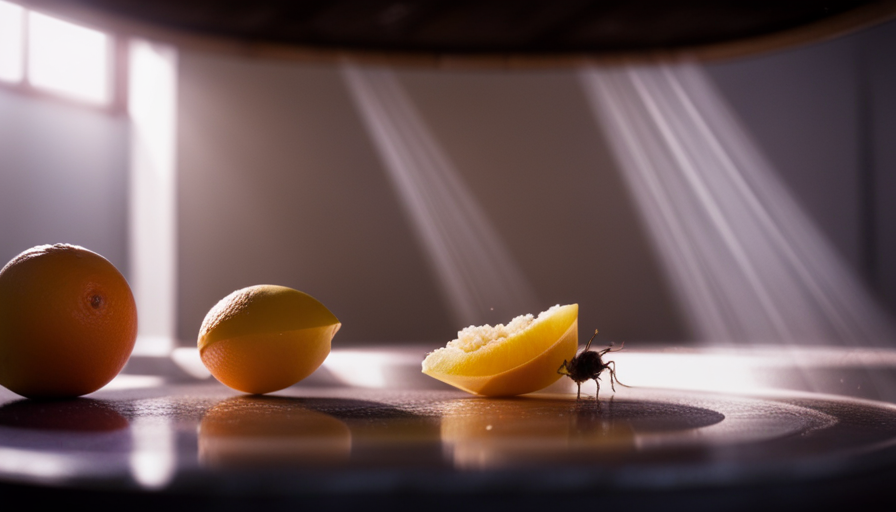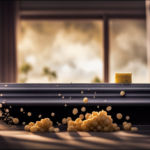Beginners Guides
What Are Those Tiny Flies In My House

Have you ever observed those annoying little insects flying around your home? The ones that seem to suddenly show up and intrude on your personal space. Allow me to acquaint you with the captivating world of small flies.
These tiny insects may be small in size, but they can cause big problems if left unchecked. In this article, we will explore the common types of tiny flies found in homes, how to identify the source of the infestation, and understand their habits and behavior. I will also share prevention tips to keep these tiny flies away, as well as natural remedies and DIY traps to eliminate them.
Additionally, I will guide you on how to properly clean and maintain your home to prevent future infestations. And if all else fails, we will discuss when it might be time to call in the professionals.
So, let’s dive in and uncover the secrets of those tiny flies in your house!
Key Takeaways
- Tiny flies commonly found in homes include fruit flies and drain flies, and it is important to identify the source of the infestation.
- Common breeding grounds for tiny flies are moist or decaying organic matter, and proper sanitation is crucial in preventing and controlling infestations.
- Home remedies such as DIY fly repellents using apple cider vinegar and essential oils, as well as homemade traps using overripe fruit and wine, can be effective in eliminating tiny flies.
- If the problem persists, it may be necessary to hire professional pest control services who can provide customized solutions and implement preventive measures.
Common Types of Tiny Flies Found in Homes
If you’re wondering what those pesky little flies buzzing around your house are, chances are they belong to one of the common types found in homes.
In kitchens, two common types of tiny flies are fruit flies and drain flies. Fruit flies are attracted to ripe or fermenting fruits and vegetables, while drain flies are typically found near drains, sewers, or decaying organic matter. These flies are not only annoying, but they can also contaminate food surfaces.
To get rid of fruit flies, you can try placing a bowl of apple cider vinegar with a few drops of dish soap near the infested area. The flies will be attracted to the vinegar and get trapped in the soapy liquid.
For drain flies, you can pour boiling water down the drain followed by a mixture of baking soda and vinegar to eliminate any organic matter that may be attracting them.
Once you’ve identified the source of the infestation, it’s important to take steps to prevent future infestations.
Identifying the Source of the Infestation
Determining the origin of the infestation can be quite challenging. When dealing with tiny flies in your house, it’s essential to identify their breeding grounds to effectively get rid of them.
These flies can breed in various places, such as decaying organic matter, moist areas, or even in the soil of potted plants. Common breeding grounds include garbage cans, drains, and rotten fruits or vegetables. By inspecting these areas, you can locate the source of the infestation and take appropriate action.
To tackle the problem, there are several effective home remedies you can try. For instance, regularly cleaning and sanitizing your garbage cans can help eliminate fly larvae and eggs. Ensuring that drains are clear of debris and using drain cleaners can also be beneficial. Additionally, storing ripe fruits and vegetables in the refrigerator or using a fruit fly trap can prevent further infestation.
Understanding the habits and behavior of tiny flies is crucial in successfully eradicating them from your home. By knowing their preferred breeding grounds and implementing effective remedies, you can significantly reduce their presence.
Transitioning into the next section, let’s explore how to prevent future infestations by understanding their habits and behavior.
Understanding the Habits and Behavior of Tiny Flies
To successfully eradicate these pesky insects from your home, it’s crucial to understand the habits and behavior of these tiny flies.
Tiny flies, also known as fruit flies or vinegar flies, have a relatively short life cycle. They typically lay their eggs in moist organic matter, such as overripe fruits, vegetables, or decaying organic materials. The eggs hatch into larvae, which feed on the organic matter and develop into pupae. Finally, adult flies emerge and start the cycle again.
When it comes to eliminating these tiny flies, using effective insecticides can be helpful. There are several types of insecticides available, such as sprays, baits, and traps, that specifically target tiny flies. These products contain chemicals that can effectively kill the flies and prevent them from reproducing.
However, it’s important to note that prevention is key to keeping tiny flies away. By practicing good sanitation and hygiene, you can significantly reduce the chances of an infestation. Regularly clean up any spilled food or liquids, dispose of overripe fruits and vegetables, and keep garbage cans tightly sealed. Additionally, make sure to repair any plumbing leaks and eliminate any standing water sources.
Understanding the habits and behavior of these tiny flies allows us to effectively combat their presence in our homes. By using the right insecticides and implementing proper prevention measures, we can keep our homes free from these annoying pests.
Prevention Tips to Keep Tiny Flies Away
To effectively prevent tiny flies from infesting your home, it’s crucial to practice good sanitation, regularly clean up spills, dispose of overripe fruits and vegetables, and keep garbage cans tightly sealed. Additionally, there are DIY fly repellents and chemical insecticides that can help keep these pesky insects at bay.
One effective DIY fly repellent is a mixture of apple cider vinegar and dish soap. The vinegar attracts the flies, while the dish soap traps and suffocates them. Another option is to make a fly spray using essential oils such as peppermint, lavender, or eucalyptus. These strong scents repel flies and can be sprayed around windows and doors.
If the infestation is severe, you may need to resort to chemical insecticides. However, it’s important to use them with caution and follow the instructions provided. Make sure to choose insecticides specifically designed for flies and use them in well-ventilated areas.
In the next section, we will delve into natural remedies and DIY traps to eliminate tiny flies. These methods can be used in conjunction with the prevention tips mentioned earlier to effectively eradicate these annoying pests from your home.
Natural Remedies and DIY Traps to Eliminate Tiny Flies
Try using natural remedies and DIY traps to get rid of those pesky little pests in your home – you’ll be amazed at how effective they can be! Natural remedies are a great way to eliminate tiny flies without the use of harmful chemicals. Here are two sub-lists with natural remedies and homemade traps you can try:
Natural Remedies:
-
Essential oils: Mix a few drops of lavender, eucalyptus, or peppermint oil with water in a spray bottle. Spray this mixture around your home, focusing on areas where you’ve seen the flies. The strong scent of these oils repels the flies.
-
Vinegar trap: Fill a small bowl with apple cider vinegar and add a few drops of dish soap. The flies are attracted to the vinegar but get trapped in the soapy solution.
Homemade Traps:
-
Fruit trap: Place a piece of overripe fruit in a jar and cover it with plastic wrap. Poke a few small holes in the plastic wrap. The flies will be attracted to the fruit and get trapped inside the jar.
-
Wine trap: Pour a small amount of red wine into a glass and cover it with plastic wrap. Poke a few holes in the plastic wrap. The flies will be lured by the scent of the wine and get trapped.
Using these natural remedies and homemade traps can significantly reduce the number of tiny flies in your home. However, it’s important to also learn how to properly clean and maintain your home to prevent infestations.
How to Properly Clean and Maintain Your Home to Prevent Infestations
Maintain a clean and tidy living space, regularly disposing of trash and keeping food items properly sealed, to prevent infestations in your home. Cleaning techniques and home maintenance are crucial in keeping those tiny flies at bay. Here are some effective strategies to help you maintain a fly-free environment.
Firstly, make sure to clean your kitchen thoroughly. Wipe down countertops, sweep and mop the floors, and clean any spills or crumbs immediately. Pay special attention to areas where food is prepared and stored, such as the pantry and refrigerator. Ensure that all food containers are tightly sealed to prevent flies from accessing them.
Regularly empty and clean your trash cans to eliminate any potential breeding grounds for flies. Additionally, keep your outdoor garbage bins tightly sealed to prevent flies from being attracted to the area.
Another important aspect of home maintenance is proper ventilation. Ensure that your windows and doors have screens in good condition to prevent flies from entering your home. Regularly clean and inspect these screens for any tears or holes that may allow flies to enter.
Incorporating these cleaning techniques and practicing regular home maintenance will greatly reduce the chances of fly infestations in your home. However, if the problem persists, it may be necessary to consider hiring professional pest control services.
Hiring Professional Pest Control Services for Persistent Infestations
Now that we’ve discussed how to clean and maintain your home to prevent infestations, let’s talk about what to do when you’re faced with persistent infestations and the need for professional pest control services arises.
When dealing with stubborn infestations, hiring professional pest control services can be a cost-effective solution in the long run. These experts have the knowledge, experience, and tools to effectively eradicate the tiny flies from your home and prevent them from returning.
Here are four reasons why hiring professional pest control services is worth considering:
-
Expertise: Pest control professionals are trained to identify the root causes of infestations and use targeted treatments to eliminate the flies.
-
Customized Solutions: They will tailor their approach to your specific situation, ensuring that the treatment is effective and long-lasting.
-
Time and Effort: Hiring professionals saves you the time and effort of trying multiple DIY methods that may not provide a permanent solution.
-
Long-Term Prevention: Pest control services not only eliminate the current infestation but also implement preventive measures to stop future infestations.
By investing in professional pest control services, you can ensure a fly-free home and enjoy peace of mind. However, it’s important to also consider the health risks associated with these tiny flies in the home.
[Transition to the next section about health risks associated with tiny flies in the home].
Health Risks Associated with Tiny Flies in the Home
Dealing with persistent infestations of these pesky insects in your home can pose potential health risks that shouldn’t be ignored. Tiny flies may seem harmless, but they can actually carry diseases and trigger allergic reactions in some individuals. It’s important to understand the health risks associated with these flies to take appropriate action.
One of the main risks of disease associated with tiny flies is their potential to transmit pathogens. These flies feed on decaying organic matter, including garbage, sewage, and rotting food. As they land on these sources, they can pick up harmful bacteria and viruses, such as E. coli and Salmonella. If they then come into contact with your food or surfaces in your home, they can contaminate them, leading to potential illness if ingested.
In addition to disease transmission, tiny flies can also cause allergic reactions in certain individuals. Their presence can trigger symptoms such as sneezing, coughing, itchy eyes, and skin rashes in sensitive individuals. This is particularly true for people with pre-existing respiratory conditions or allergies.
To better understand the health risks associated with tiny flies, take a look at the table below:
| Health Risk | Description |
|---|---|
| Disease Transmission | Tiny flies can carry pathogens that can contaminate food and surfaces, leading to potential illness if ingested. |
| Allergic Reactions | Some individuals may experience allergic reactions, such as sneezing, coughing, itchy eyes, and skin rashes, in the presence of tiny flies. |
By being aware of these health risks, you can take appropriate measures to eliminate the infestation and protect your health and wellbeing. In the next section, we will discuss common mistakes to avoid when dealing with tiny fly infestations.
Common Mistakes to Avoid When Dealing with Tiny Fly Infestations
Avoiding common mistakes when dealing with a tiny fly infestation is crucial for safeguarding your health and ensuring a pest-free home. Here are some common misconceptions about tiny flies and signs that you may have a tiny fly infestation:
-
Ignoring the issue: One common mistake is assuming that a few tiny flies are harmless and will go away on their own. However, this can lead to a full-blown infestation, causing health risks and inconvenience.
-
Overlooking breeding grounds: Tiny flies, such as fruit flies or drain flies, often breed in moist or decaying organic matter. Check areas like kitchen sinks, garbage disposals, and drains to identify potential breeding grounds.
-
Not addressing the source: Simply swatting or using fly swatters may temporarily eliminate a few flies, but it won’t solve the root problem. It is important to find and eliminate the source of the infestation to prevent reoccurrence.
-
Neglecting proper sanitation: Maintaining cleanliness is crucial in preventing and controlling tiny fly infestations. Regularly clean and disinfect areas where flies are commonly found, such as kitchen countertops, trash cans, and recycling bins.
Signs of a tiny fly infestation include an increase in fly sightings, the presence of small flies near food or drains, and an unpleasant odor in the affected area. By avoiding these common mistakes and taking proactive measures, you can effectively deal with a tiny fly infestation and maintain a pest-free environment.
Frequently Asked Questions
How many species of tiny flies are commonly found in homes?
There are several species of tiny flies commonly found in homes. These flies, also known as common house flies, can include fruit flies, drain flies, or fungus gnats.
Can tiny flies transmit diseases to humans?
Tiny flies can transmit diseases to humans, such as food poisoning and eye infections. Additionally, they can cause allergies in some individuals. However, they also have benefits to the environment, like pollinating flowers and breaking down organic matter.
Are there any specific home maintenance practices that can prevent tiny fly infestations?
To prevent tiny fly infestations, effective methods include removing them from houseplants by washing leaves and using insecticidal soap. Proper food storage, such as sealing containers tightly, also plays a vital role in preventing infestations.
How long does it take for natural remedies and DIY traps to eliminate tiny flies?
Natural remedies and DIY traps can take anywhere from a few days to a few weeks to eliminate tiny flies. The efficacy of these methods depends on the specific remedy or trap used and the severity of the infestation.
What are the signs that indicate a persistent infestation of tiny flies that requires professional pest control services?
Signs of a persistent infestation include a sudden increase in fly population, finding larvae or pupae in hidden areas, and a strong, musty odor. Professional pest control is crucial to eliminate the infestation completely and prevent future outbreaks.
Conclusion
In conclusion, these tiny flies buzzing around our homes can be quite a nuisance. But fear not, with proper identification and understanding of their habits, we can effectively prevent and eliminate their presence.
By implementing natural remedies, DIY traps, and maintaining a clean environment, we can keep these pesky insects at bay. However, for persistent infestations, it may be necessary to seek the help of professional pest control services.
Remember, a tiny fly-free home is a serene oasis, where you can relax and enjoy the sweet fragrance of peace.
Hi, I’m Emma. I’m the Editor in Chief of Tiny House 43, a blog all about tiny houses. While tree houses are often associated with childhood, they can be the perfect adult retreat. They offer a cozy space to relax and unwind, surrounded by nature. And since they’re typically built on stilts or raised platforms, they offer stunning views that traditional homes simply can’t match. If you’re looking for a unique and romantic getaway, a tree house tiny house might just be the perfect option.
Beginners Guides
How Cheap Can a Tiny House Shellon Wheels Cost

I have exciting news for all the budget-friendly tiny house fans out there! Brace yourself, as we are about to explore the realm of extremely affordable tiny house shells on wheels.
You won’t believe how cheap these gems can be. I’ve done my research, and I’m here to spill all the details on finding the best bargains, DIY methods, and cost-saving tips for customizing your dream home.
So, buckle up and prepare to embark on a journey towards affordable tiny house living!
Key Takeaways
- Affordable options for tiny house shells include using budget-friendly materials like reclaimed wood, recycled metal, and alternative building materials.
- DIY methods for building a budget-friendly tiny house shell include using reclaimed or salvaged materials, incorporating creative space-saving solutions, and repurposing items for storage.
- Bargains for cheap tiny house shells on wheels can be found by searching online marketplaces, attending local auctions, researching and comparing prices, and negotiating the price.
- Cost-saving tips for customizing a tiny house shell include utilizing multipurpose furniture, taking on DIY projects, maximizing storage with shelves and hooks, and looking for cost-saving hacks like repurposed furniture and DIY decor.
Researching Affordable Tiny House Shell Options
I’ll start by exploring different manufacturers that offer affordable tiny house shell options. When it comes to constructing a tiny house shell on a budget, it’s essential to consider using budget-friendly materials. Many manufacturers understand the need for cost-effective solutions and offer options that cater to this market. These include using materials like reclaimed wood, recycled metal, and alternative building materials. By using these budget-friendly materials, you can significantly reduce the overall cost of your tiny house shell build.

In addition to using budget-friendly materials, there are creative ways to save money on a tiny house shell build. One option is to purchase a pre-built tiny house shell from a manufacturer. This allows you to take advantage of their bulk purchasing power and expertise to get a high-quality shell at a lower cost. Another option is to explore DIY kits that come with pre-cut materials and instructions, allowing you to save money by doing the construction yourself.
Transitioning into the next section, let’s now explore DIY methods for building a budget-friendly tiny house shell.
Exploring DIY Methods for Building a Budget-Friendly Tiny House Shell
Let’s delve into various DIY techniques to construct a budget-friendly tiny house shell.
When it comes to building a tiny house on a budget, exploring alternative materials is key. Instead of traditional lumber, consider using reclaimed or salvaged materials to save money and reduce waste.

Additionally, creative space-saving solutions can make a big difference in maximizing the functionality of your tiny house. Utilize multifunctional furniture, like a sofa that converts into a bed or a foldable dining table.
Think outside the box and repurpose items for storage, such as using old suitcases as shelves or installing hooks on walls for hanging pots and pans.
Finding Bargains: Where to Look for Cheap Tiny House Shells on Wheels
Scouring online marketplaces and attending local auctions can be effective strategies for finding cheap tiny house shells on wheels. When searching for affordable options, it’s important to know where to look and how to negotiate the price. Here are some tips to help you in your search:
- Best websites for finding affordable tiny house shells on wheels:
| Website | Description |
|---|---|
| Tiny House Listings | A popular online marketplace for tiny houses |
| Craigslist | Local classifieds often have listings for shells |
| eBay | Auction-style platform with various options |
- Tips for negotiating the price of a cheap tiny house shell on wheels:
- Do your research and compare prices to know the market value.
- Be prepared to negotiate and offer a lower price.
- Highlight any repairs or modifications needed as leverage for a lower price.
- Consider purchasing in the off-season when prices might be lower.
Cost-Saving Tips for Customizing Your Tiny House Shell
When customizing my tiny house shell, I often look for cost-saving tips to stay within my budget. Here are some customization ideas and space-saving solutions that can help you save money while still creating a functional and beautiful tiny home:

-
Utilize multipurpose furniture: Look for furniture pieces that can serve multiple functions, such as a sofa that can be transformed into a bed or a table with built-in storage.
-
DIY projects: Instead of buying expensive custom-built furniture or storage solutions, consider taking on some do-it-yourself projects. You can repurpose old materials or find affordable options at thrift stores or online marketplaces.
-
Optimize vertical space: Maximize storage by utilizing vertical space. Install shelves, hooks, and hanging organizers to make the most of every inch. You can also consider using wall-mounted folding tables or Murphy beds to save space.
Comparing Prices: How Much Can You Save With a Tiny House Shell on Wheels?
I saved a significant amount of money by comparing prices and opting for a tiny house shell on wheels rather than a traditional home. When I started exploring financing options for my tiny house, I was amazed at how much more affordable it was compared to a conventional house. Not only did I save on the initial cost of construction, but I also avoided the expenses associated with buying land and paying property taxes. Additionally, the mobility of a tiny house shell on wheels offers several benefits. I can easily move my home to different locations, allowing me to explore new areas and experience different communities. It also gives me the flexibility to live closer to work or family if needed. Overall, choosing a tiny house shell on wheels has not only saved me money, but it has also provided me with a sense of freedom and adventure.

| Benefits of a Mobile Tiny House | Cost Savings |
|---|---|
| Mobility and flexibility | Lower construction cost |
| Opportunity to explore new areas | No property taxes |
| Ability to live closer to work or family | No land purchase expenses |
Frequently Asked Questions
What Are the Common Challenges Faced When Researching Affordable Tiny House Shell Options?
When researching affordable tiny house shell options, one of the common challenges is finding reliable information. It requires thorough research to ensure the options are truly affordable and meet one’s specific needs.
Are There Any Specific Materials or Techniques That Can Help in Building a Budget-Friendly Tiny House Shell?
Budget-friendly materials and construction techniques are essential when building a tiny house shell. By using cost-effective materials and efficient construction methods, it is possible to create a budget-friendly tiny house on wheels.
Where Can I Find Reliable Sources for Cheap Tiny House Shells on Wheels?
Finding affordable tiny house shells on wheels can be a challenge, but with some expert bargain hunting, it is possible to find reliable sources. It’s important to research extensively and compare prices to ensure you get the best deal.
What Are Some Cost-Saving Tips or Hacks for Customizing a Tiny House Shell?
When it comes to customizing a tiny house shell, there are several cost-saving tips and hacks to consider. From using budget-friendly materials to DIY projects, these strategies can help keep your expenses low while still creating a personalized and comfortable space.

How Does the Price of a Tiny House Shell on Wheels Compare to Other Housing Options in Terms of Long-Term Savings?
In terms of long-term savings, a tiny house shell on wheels can offer significant financial benefits. Compared to other housing options, it allows for lower utility costs and fewer maintenance expenses, making it a cost-effective choice.
Conclusion
After researching affordable options and exploring DIY methods, it’s clear that a tiny house shell on wheels can be an incredibly cost-effective choice.
By finding bargains and utilizing cost-saving tips, individuals can customize their tiny house shell to fit their needs and save even more money.
Comparing prices will reveal just how much can be saved with this practical and budget-friendly housing solution.

So why wait? Take the leap into the world of tiny house living and start saving today.
I’m Theodore, and I love tiny houses. In fact, I’m the author of Tiny House 43, a book about tiny houses that are also tree houses. I think they’re magical places where imaginations can run wild and adventures are just waiting to happen.
While tree houses are often associated with childhood, they can be the perfect adult retreat. They offer a cozy space to relax and unwind, surrounded by nature. And since they’re typically built on stilts or raised platforms, they offer stunning views that traditional homes simply can’t match.
If you’re looking for a unique and romantic getaway, a tree house tiny house might just be the perfect option.
Beginners Guides
How Can You Save Money While Living in a Tiny House on Wheels

As someone who lives in a tiny house on wheels, I’ve discovered that downsizing does not equate to compromising financial stability. On the contrary, it can actually lead to improved financial security!
By embracing a minimalist lifestyle and making smart choices, I’ve discovered countless ways to save money. From efficient energy use to creative storage solutions, this article will show you how to keep more cash in your pocket while enjoying the freedom and simplicity of tiny house living.
Let’s dive in and uncover the secrets to financial freedom on the move!
Key Takeaways
- Incorporate smart home technology to efficiently use energy and reduce utility costs.
- Minimize maintenance costs by regularly inspecting and maintaining all systems and components.
- Utilize creative storage solutions to maximize space and reduce the need for additional storage.
- Grow your own food to save money and enjoy the benefits of fresh, homegrown produce.
Efficient Energy Use
I can save money by using efficient energy in my tiny house on wheels.

One way to achieve this is by incorporating smart home technology into my energy systems. Smart home technology allows me to monitor and control the energy consumption of my appliances and devices remotely. By using smart plugs, smart thermostats, and smart lighting systems, I can ensure that energy is only used when needed, reducing wastage and ultimately saving money.
Another way to save money is by utilizing renewable energy sources. Installing solar panels on the roof of my tiny house allows me to harness the power of the sun to generate electricity. Not only is this environmentally friendly, but it also reduces my reliance on the grid and lowers my energy bills. Additionally, using wind turbines or micro-hydro systems can further supplement my energy needs.
Minimizing Maintenance Costs
To minimize maintenance costs while living in a tiny house on wheels, it’s important to regularly inspect and maintain all systems and components. By taking a proactive approach, you can reduce the need for costly repairs and optimize the resources available to you. Here are some practical tips to help you minimize maintenance costs:
| Maintenance Tips | Benefits |
|---|---|
| Regularly check for leaks and water damage | Prevents costly repairs due to water damage |
| Clean and lubricate moving parts | Extends the lifespan of mechanical components |
| Keep the exterior clean and well-maintained | Prevents rust and deterioration |
| Inspect and maintain electrical systems | Reduces the risk of electrical issues and potential hazards |
Creative Storage Solutions
Maximizing storage space is crucial when living in a tiny house on wheels. In order to make the most of the limited space available, it’s important to utilize creative storage solutions.

One way to achieve this is by incorporating hidden compartments into your furniture. For example, you can have a bed with built-in storage underneath or a coffee table that opens up to reveal additional space. This allows you to keep your belongings neatly tucked away, while still having easy access to them.
Another option is to invest in multi-functional furniture. This means choosing pieces that serve more than one purpose. For instance, a sofa that can also be used as a bed or a dining table that can be folded away when not in use.
Growing Your Own Food
One way to save money while living in a tiny house on wheels is by growing your own food and incorporating it into your meals. Vertical gardening and hydroponic systems are excellent options for maximizing space and growing a variety of fruits, vegetables, and herbs.
Vertical gardening involves growing plants vertically, using walls or structures to support them. This allows you to make the most of limited space and grow a larger quantity of produce.

Hydroponic systems, on the other hand, allow you to grow plants without soil, using nutrient-rich water instead. This method is highly efficient and can produce higher yields compared to traditional gardening.
By growing your own food, you not only save money but also have the satisfaction of knowing exactly where your food comes from.
Transitioning into embracing a minimalist lifestyle, let’s explore how to downsize your possessions and simplify your living space.
Embracing a Minimalist Lifestyle
I love the freedom that comes with embracing a minimalist lifestyle in my tiny house on wheels. Living in a small space has forced me to reassess my belongings and prioritize what’s truly important.

Here are three ways that embracing a minimalist lifestyle in a tiny house on wheels can lead to sustainable living and reduce your environmental impact:
-
Decluttering: By getting rid of excess possessions, you’re reducing waste and promoting a more mindful consumption. This leads to a simpler and more sustainable way of living.
-
Energy Efficiency: With limited space, you become more conscious of your energy consumption. Installing energy-efficient appliances and using natural light can significantly reduce your environmental footprint.
-
Eco-friendly Materials: Choosing sustainable and durable materials for your tiny house, such as reclaimed wood or recycled materials, not only reduces waste but also helps to preserve natural resources.

Embracing a minimalist lifestyle in a tiny house on wheels can’t only save you money but also contribute to a more sustainable and environmentally friendly way of living.
Frequently Asked Questions
How Can I Legally Live in a Tiny House on Wheels?
To legally live in a tiny house on wheels, you need to research and comply with local zoning laws and building codes. Ensure your tiny house meets all legal requirements and obtain necessary permits for parking and utilities.
What Are the Potential Challenges of Living in a Tiny House on Wheels?
Living in a tiny house on wheels presents potential challenges, such as limited space and mobility restrictions. However, with some tips and tricks, like minimizing possessions and conserving resources, it is possible to overcome these challenges and live comfortably.
Are There Any Specific Restrictions or Regulations for Parking a Tiny House on Wheels?
Parking restrictions and legal requirements for tiny houses on wheels vary depending on location. It’s important to research local zoning laws, building codes, and permit requirements to ensure compliance and avoid any potential fines or legal issues.

Can I Still Have a Comfortable and Functional Living Space in a Tiny House on Wheels?
Yes, it is possible to have a comfortable and functional living space in a tiny house on wheels. By maximizing storage, utilizing multipurpose furniture, and prioritizing organization, you can create a space that meets your needs.
How Can I Ensure the Safety and Security of My Tiny House on Wheels?
To ensure privacy and prevent theft in my tiny house on wheels, I can implement security measures like installing sturdy locks, using window coverings, and keeping valuable items out of sight.
Conclusion
Living in a tiny house on wheels can be a great way to save money. By focusing on efficient energy use, minimizing maintenance costs, creative storage solutions, and growing your own food, you can significantly reduce your expenses.
Embracing a minimalist lifestyle is also key to saving money in a tiny house. Did you know that the average cost to build a tiny house is only around $23,000, compared to the average cost of a traditional house, which is over $200,000?

I’m Theodore, and I love tiny houses. In fact, I’m the author of Tiny House 43, a book about tiny houses that are also tree houses. I think they’re magical places where imaginations can run wild and adventures are just waiting to happen.
While tree houses are often associated with childhood, they can be the perfect adult retreat. They offer a cozy space to relax and unwind, surrounded by nature. And since they’re typically built on stilts or raised platforms, they offer stunning views that traditional homes simply can’t match.
If you’re looking for a unique and romantic getaway, a tree house tiny house might just be the perfect option.
Beginners Guides
How Cheap Can I Build a Tiny House Starting Now

- Building codes and safety requirements
- Environmental impact and sustainability measures
I’m here to let you know that constructing a small house doesn’t have to cost a fortune. Visualize a snug area, custom-made to suit your requirements, all within your financial means.
In this article, I’ll share practical tips and strategies for building a cheap tiny house starting right now. From planning your budget to finding affordable materials, I’ll guide you through the process of creating your dream home without breaking the bank.
Let’s get started on this exciting and budget-friendly journey!
Key Takeaways
- Determine available funds and explore different financing options to keep costs low
- Look for affordable building materials at salvage yards, thrift stores, and online marketplaces
- Consider the advantages and disadvantages of DIY versus hiring professionals based on personal preferences and skills
- Incorporate cost-saving design strategies such as using salvaged materials, maximizing space, and incorporating sustainable building methods
Planning Your Budget
I can start planning my budget by figuring out how much money I’ve to work with. It’s crucial to determine the amount of funds available before proceeding with any construction project.

To ensure cost-effective construction methods, it’s essential to explore different financing options. This will help me identify the most suitable approach for my tiny house project. Researching and comparing various financing options, such as personal loans, home equity loans, or even crowdfunding, can provide me with the necessary resources to build my tiny house while keeping costs low.
Additionally, I can consider utilizing cost-effective construction methods, such as using recycled or repurposed materials, which can significantly reduce expenses.
Finding Affordable Materials
How can I find affordable materials for my tiny house project? Here are four ways to save money when it comes to finding materials:
-
Salvaging materials: Look for building materials at salvage yards, thrift stores, or online marketplaces. You can find reclaimed wood, windows, doors, and other items that are in good condition but at a fraction of the cost.

-
Bartering for supplies: Explore the option of bartering with others who may have excess materials or tools. You can trade your skills or services in exchange for the items you need for your tiny house. It’s a win-win situation for both parties involved.
-
Joining community groups: Connect with local community groups or online forums where people share resources and materials for their projects. You can find people who are willing to give away or sell their unused materials at a lower price.
-
Reaching out to local businesses: Contact local construction companies, hardware stores, or home improvement centers and ask if they have any excess or discounted materials. Sometimes, they may have leftover materials from larger projects that they’re willing to sell at a discounted price.
DIY Vs Hiring Professionals
The decision to hire professionals or take the DIY route is an important consideration when building a tiny house. Both options have their pros and cons, and it ultimately depends on your personal preferences and skills. Hiring professionals can ensure that the construction is done efficiently and up to code, but it can also be costly. On the other hand, DIY allows for personal satisfaction and potential cost savings, but it requires more time, effort, and expertise. To help you make an informed decision, here is a table highlighting the advantages and disadvantages of each approach:

| Professionals | DIY | |
|---|---|---|
| Pros | – Expertise | – Personal satisfaction |
| – Efficiency | – Potential cost savings | |
| Cons | – Higher cost | – Time-consuming |
| – Less control | – Requires skills |
Considering the pros and cons of hiring professionals versus taking the DIY route, it’s important to evaluate your own capabilities, budget, and desired level of involvement. Now, let’s explore some cost-saving design strategies for building a cheap but functional tiny house.
Cost-Saving Design Strategies
By employing cost-saving design strategies, I’ve discovered that it’s possible to build a cheap yet functional tiny house. Here are four sustainable building methods and repurposing materials that can help you save money while creating your dream tiny house:
-
Use salvaged materials: Instead of buying new, consider repurposing materials such as reclaimed wood, windows, and doors. You can find these items at salvage yards or online marketplaces, often at a fraction of the cost.
-
Optimize space: Maximize the functionality of your tiny house by designing multi-purpose furniture and storage solutions. Utilize built-in shelving, hidden compartments, and convertible furniture to make the most of every square inch.

-
Energy-efficient design: Incorporate sustainable building methods such as proper insulation, energy-efficient windows, and solar panels. These investments may initially cost more but will save you money in the long run by reducing energy bills.
-
DIY projects: Take on certain tasks yourself, such as painting, flooring, and basic carpentry. By learning new skills and doing the work yourself, you can significantly cut down on labor costs.
Tips for Minimizing Ongoing Expenses
One effective way I’ve found to minimize ongoing expenses is by implementing a monthly budget and tracking my spending. By carefully monitoring my expenses, I’m able to identify areas where I can cut costs and make more sustainable choices.
One important aspect of minimizing ongoing expenses in a tiny house is by investing in energy efficient appliances. These appliances may have a higher upfront cost, but they can significantly reduce energy consumption and save money in the long run.

Additionally, using sustainable building materials can help save on ongoing expenses. Materials such as reclaimed wood or recycled insulation not only reduce environmental impact but also provide cost savings by being more durable and requiring less maintenance.
Frequently Asked Questions
What Are the Necessary Permits and Regulations for Building a Tiny House?
When considering permits and regulations for building a tiny house, it’s important to prioritize adherence to building codes and safety requirements, as well as incorporating environmental impact and sustainability measures into the design and construction process.
How Much Does It Cost to Connect Utilities to a Tiny House?
To connect utilities to a tiny house, the cost will depend on factors like location, distance from existing infrastructure, and type of utilities needed. Off-grid living and alternative energy sources can help reduce the cost of connecting utilities.
Is It Possible to Build a Tiny House Without Any Construction Experience?
Building a tiny house without construction experience is challenging but possible. With tips and tricks for building on a budget and finding affordable materials, anyone can create their dream home.

Are There Any Zoning Restrictions or Limitations on Where I Can Park a Tiny House?
Zoning restrictions and parking limitations vary depending on the location. It’s crucial to research local regulations and consult with the appropriate authorities. Understanding these rules will help ensure a smooth process for parking your tiny house.
How Can I Finance the Construction of a Tiny House?
Financing the construction of a tiny house requires careful planning and budgeting. There are various financing options available, such as personal loans or RV loans. Research different lenders and compare interest rates to find the best deal.
Conclusion
In conclusion, building a cheap tiny house is definitely possible with careful planning and budgeting. By sourcing affordable materials, considering DIY options, and implementing cost-saving design strategies, you can create a functional and cozy living space without breaking the bank.
Remember, every penny saved adds up, so be diligent in finding the best deals and minimizing ongoing expenses. With a bit of creativity and resourcefulness, you can turn your dream of a tiny house into a reality.

As the saying goes, ‘A penny saved is a penny earned.’
I’m Theodore, and I love tiny houses. In fact, I’m the author of Tiny House 43, a book about tiny houses that are also tree houses. I think they’re magical places where imaginations can run wild and adventures are just waiting to happen.
While tree houses are often associated with childhood, they can be the perfect adult retreat. They offer a cozy space to relax and unwind, surrounded by nature. And since they’re typically built on stilts or raised platforms, they offer stunning views that traditional homes simply can’t match.
If you’re looking for a unique and romantic getaway, a tree house tiny house might just be the perfect option.
-

 Beginners Guides1 week ago
Beginners Guides1 week agoHow To Buy A Tesla Tiny House
-

 Energy Efficiency1 month ago
Energy Efficiency1 month agoBest Tiny Homes For Cold Climates
-

 Beginners Guides6 days ago
Beginners Guides6 days agoTiny House Nation Where Are They Now Stephanie
-

 Tiny House Resources (e.g., legalities, cost, insurance, FAQs)2 months ago
Tiny House Resources (e.g., legalities, cost, insurance, FAQs)2 months agoDo Tiny Homes Need Planning Permission?
-

 Beginners Guides2 weeks ago
Beginners Guides2 weeks agoFrom The Show Tiny House Nation How Many Keep Their Tiny House?
-

 Beginners Guides2 months ago
Beginners Guides2 months agoUsing a Climbing Net For Treehouse Construction
-

 Beginners Guides2 months ago
Beginners Guides2 months agoHow to Build a Treehouse Without Drilling Into the Tree
-

 Beginners Guides3 weeks ago
Beginners Guides3 weeks agoTiny House Nation Who Pays For The Houses













